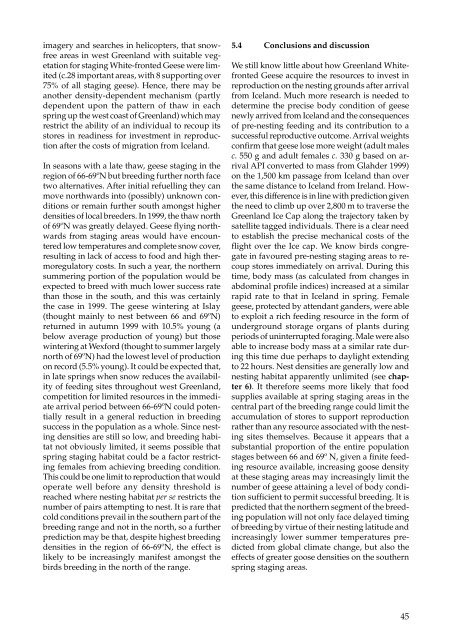The Greenland White-fronted Goose Anser albifrons flavirostris
The Greenland White-fronted Goose Anser albifrons flavirostris
The Greenland White-fronted Goose Anser albifrons flavirostris
Create successful ePaper yourself
Turn your PDF publications into a flip-book with our unique Google optimized e-Paper software.
imagery and searches in helicopters, that snowfree<br />
areas in west <strong>Greenland</strong> with suitable vegetation<br />
for staging <strong>White</strong>-<strong>fronted</strong> Geese were limited<br />
(c.28 important areas, with 8 supporting over<br />
75% of all staging geese). Hence, there may be<br />
another density-dependent mechanism (partly<br />
dependent upon the pattern of thaw in each<br />
spring up the west coast of <strong>Greenland</strong>) which may<br />
restrict the ability of an individual to recoup its<br />
stores in readiness for investment in reproduction<br />
after the costs of migration from Iceland.<br />
In seasons with a late thaw, geese staging in the<br />
region of 66-69ºN but breeding further north face<br />
two alternatives. After initial refuelling they can<br />
move northwards into (possibly) unknown conditions<br />
or remain further south amongst higher<br />
densities of local breeders. In 1999, the thaw north<br />
of 69ºN was greatly delayed. Geese flying northwards<br />
from staging areas would have encountered<br />
low temperatures and complete snow cover,<br />
resulting in lack of access to food and high thermoregulatory<br />
costs. In such a year, the northern<br />
summering portion of the population would be<br />
expected to breed with much lower success rate<br />
than those in the south, and this was certainly<br />
the case in 1999. <strong>The</strong> geese wintering at Islay<br />
(thought mainly to nest between 66 and 69ºN)<br />
returned in autumn 1999 with 10.5% young (a<br />
below average production of young) but those<br />
wintering at Wexford (thought to summer largely<br />
north of 69ºN) had the lowest level of production<br />
on record (5.5% young). It could be expected that,<br />
in late springs when snow reduces the availability<br />
of feeding sites throughout west <strong>Greenland</strong>,<br />
competition for limited resources in the immediate<br />
arrival period between 66-69ºN could potentially<br />
result in a general reduction in breeding<br />
success in the population as a whole. Since nesting<br />
densities are still so low, and breeding habitat<br />
not obviously limited, it seems possible that<br />
spring staging habitat could be a factor restricting<br />
females from achieving breeding condition.<br />
This could be one limit to reproduction that would<br />
operate well before any density threshold is<br />
reached where nesting habitat per se restricts the<br />
number of pairs attempting to nest. It is rare that<br />
cold conditions prevail in the southern part of the<br />
breeding range and not in the north, so a further<br />
prediction may be that, despite highest breeding<br />
densities in the region of 66-69ºN, the effect is<br />
likely to be increasingly manifest amongst the<br />
birds breeding in the north of the range.<br />
5.4 Conclusions and discussion<br />
We still know little about how <strong>Greenland</strong> <strong>White</strong><strong>fronted</strong><br />
Geese acquire the resources to invest in<br />
reproduction on the nesting grounds after arrival<br />
from Iceland. Much more research is needed to<br />
determine the precise body condition of geese<br />
newly arrived from Iceland and the consequences<br />
of pre-nesting feeding and its contribution to a<br />
successful reproductive outcome. Arrival weights<br />
confirm that geese lose more weight (adult males<br />
c. 550 g and adult females c. 330 g based on arrival<br />
API converted to mass from Glahder 1999)<br />
on the 1,500 km passage from Iceland than over<br />
the same distance to Iceland from Ireland. However,<br />
this difference is in line with prediction given<br />
the need to climb up over 2,800 m to traverse the<br />
<strong>Greenland</strong> Ice Cap along the trajectory taken by<br />
satellite tagged individuals. <strong>The</strong>re is a clear need<br />
to establish the precise mechanical costs of the<br />
flight over the Ice cap. We know birds congregate<br />
in favoured pre-nesting staging areas to recoup<br />
stores immediately on arrival. During this<br />
time, body mass (as calculated from changes in<br />
abdominal profile indices) increased at a similar<br />
rapid rate to that in Iceland in spring. Female<br />
geese, protected by attendant ganders, were able<br />
to exploit a rich feeding resource in the form of<br />
underground storage organs of plants during<br />
periods of uninterrupted foraging. Male were also<br />
able to increase body mass at a similar rate during<br />
this time due perhaps to daylight extending<br />
to 22 hours. Nest densities are generally low and<br />
nesting habitat apparently unlimited (see chapter<br />
6). It therefore seems more likely that food<br />
supplies available at spring staging areas in the<br />
central part of the breeding range could limit the<br />
accumulation of stores to support reproduction<br />
rather than any resource associated with the nesting<br />
sites themselves. Because it appears that a<br />
substantial proportion of the entire population<br />
stages between 66 and 69º N, given a finite feeding<br />
resource available, increasing goose density<br />
at these staging areas may increasingly limit the<br />
number of geese attaining a level of body condition<br />
sufficient to permit successful breeding. It is<br />
predicted that the northern segment of the breeding<br />
population will not only face delayed timing<br />
of breeding by virtue of their nesting latitude and<br />
increasingly lower summer temperatures predicted<br />
from global climate change, but also the<br />
effects of greater goose densities on the southern<br />
spring staging areas.<br />
45


